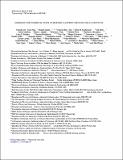Por favor, use este identificador para citar o enlazar a este item:
http://hdl.handle.net/10261/215969COMPARTIR / EXPORTAR:
 SHARE SHARE
 CORE
BASE CORE
BASE
|
|
| Visualizar otros formatos: MARC | Dublin Core | RDF | ORE | MODS | METS | DIDL | DATACITE | |

| Título: | Unveiling the Dynamical State of Massive Clusters through the ICL Fraction |
Autor: | Jiménez-Teja, Y. CSIC ORCID CVN; Dupke, Renato A.; Benítez, Narciso CSIC ORCID; Koekemoer, Anton M.; Zitrin, Adi; Umetsu, Keiichi; Ziegler, Bodo L.; Frye, Brenda L.; Ford, Holland; Bouwens, Rychard J.; Bradley, Larry D.; Broadhurst, Thomas; Coe, Dan; Donahue, Megan; Graves, Genevieve J.; Grillo, Claudio; Infante, Leopoldo; Jouvel, Stephanie; Kelson, Daniel D.; Lahav, Ofer; Lazkoz, Ruth; Lemze, Dorom; Maoz, Dan; Medezinski, Elinor; Melchior, Peter; Meneghetti, Massimo; Mercurio, Amata; Merten, Julian; Molino, Alberto CSIC ORCID; Moustakas, Leonidas A.; Nonino, Mario; Ogaz, Sara; Riess, Adam G.; Rosati, Piero; Sayers, Jack; Seitz, Stella; Zheng, Wei | Palabras clave: | Galaxies: clusters: general Techniques: image processing |
Fecha de publicación: | 2018 | Editor: | IOP Publishing | Citación: | Astrophysical Journal 857(2): 79 (2018) | Resumen: | We have selected a sample of 11 massive clusters of galaxies observed by the Hubble Space Telescope in order to study the impact of the dynamical state on the intracluster light (ICL) fraction, the ratio of total integrated ICL to the total galaxy member light. With the exception of the Bullet cluster, the sample is drawn from the Cluster Lensing and Supernova Survey and the Frontier Fields program, containing five relaxed and six merging clusters. The ICL fraction is calculated in three optical filters using the CHEFs ICL estimator, a robust and accurate algorithm free of a priori assumptions. We find that the ICL fraction in the three bands is, on average, higher for the merging clusters, ranging between ∼7% and 23%, compared with the ∼2%-11% found for the relaxed systems. We observe a nearly constant value (within the error bars) in the ICL fraction of the regular clusters at the three wavelengths considered, which would indicate that the colors of the ICL and the cluster galaxies are, on average, coincident and, thus, so are their stellar populations. However, we find a higher ICL fraction in the F606W filter for the merging clusters, consistent with an excess of lower-metallicity/younger stars in the ICL, which could have migrated violently from the outskirts of the infalling galaxies during the merger event. © 2018. The American Astronomical Society. All rights reserved. | Versión del editor: | http://dx.doi.org/10.3847/1538-4357/aab70f | URI: | http://hdl.handle.net/10261/215969 | DOI: | 10.3847/1538-4357/aab70f | Identificadores: | doi: 10.3847/1538-4357/aab70f e-issn: 1538-4357 issn: 0004-637X |
| Aparece en las colecciones: | (IAA) Artículos |
Ficheros en este ítem:
| Fichero | Descripción | Tamaño | Formato | |
|---|---|---|---|---|
| IAA_2018ApJ...857...79J.pdf | 1,47 MB | Adobe PDF |  Visualizar/Abrir |
CORE Recommender
SCOPUSTM
Citations
40
checked on 18-abr-2024
WEB OF SCIENCETM
Citations
32
checked on 20-feb-2024
Page view(s)
126
checked on 24-abr-2024
Download(s)
110
checked on 24-abr-2024
Google ScholarTM
Check
Altmetric
Altmetric
NOTA: Los ítems de Digital.CSIC están protegidos por copyright, con todos los derechos reservados, a menos que se indique lo contrario.
